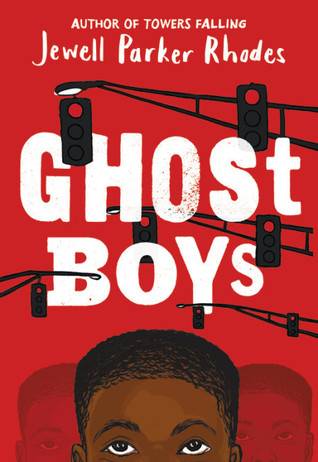Ghost Boys
Written by Jewell Parker Rhodes
Little, Brown and Company, 2018, 214 pp.
ISBN 978-0316262286
2019 Jane Addams Children’s Book Award
Winner, Books for Older Children
Ghost Boys is a haunting tale with an all-too familiar tragedy at its core — the fatal shooting of an African-American youth by a white police officer who mistook the boy’s toy gun for a real one.
Often the target of bullying at school, Jerome doesn’t have a close friend, but that changes when he meets Carlos, whose family has just moved to Chicago from Texas. To evade the class bullies, who have also targeted Carlos, Jerome and his new friend eat their lunches in the bathroom, squatting in stalls on top of the toilets to avoid being detected. Despite these coping methods, the bullies find and threaten Carlos and Jerome, but Carlos is able to send them running when he brandishes his toy gun. The bullies — as well as Jerome–are terrified by Carlos’s weapon, and only after the bullies leave does Carlos reveal to Jerome that his gun is actually a toy. Jerome accepts Carlos’s offer to take the toy home and play with it, which ultimately leads to Jerome’s death at the hands of the officer.
Rhodes has twelve-year-old Jerome tell his story, alternating between his own two points of view of “dead” and “alive.” Her effective use of this narrative device gives readers unique insight by weaving in magical realism when Jerome’s spirit interacts with the ghosts of other African-American youth who were murdered by white adults, in particular, Emmett Till. In addition, Rhodes connects injustices of the past with those of today.
The story opens with Jerome observing his slain body moments after the officer fired the two fatal shots. Lying face down on the pavement in an abandoned lot he observes his own blood puddling and quickly staining his new sneakers. Soon, Jerome describes the wails of his mother as she is held back by police while sirens scream in the background. In the “alive” sections of the story, Jerome describes his daily life, hopes, and dreams as a twelve-year-old. Readers understand Jerome’s deep love and loyalty to his parents, his younger sister, and his grandmother. Reflecting the reality of so many African-American families, Jerome’s parents and grandmother remind him every day to come straight home from school to avoid neighborhood dangers and that nothing is more important than his education. Jerome listens and heeds their words, until the day he is shot while imaginatively chasing “bad guys” (p. 195) with Carlos’s toy gun.
After his death, Jerome agonizes as he watches his family mourn his loss and grieve the injustice when the officer is not charged with a crime. When Jerome first encounters Emmett Till, he is unfamiliar with Till’s story, and Till decides to wait a while before sharing it. Jerome gradually learns why the “ghost boys” are accompanying him. Even more startling, Jerome soon finds himself visible to Sarah, the daughter of the officer who killed him. Jerome, at first dismissive of Sarah as a privileged, uncaring white girl, soon learns that she is deeply troubled by her father’s actions and doubtful about his claim that he was in fear for his life when he shot Jerome. Sarah’s character is a powerful symbol of the responsibility that society must take against this injustice. After the court decides that her father will not be charged with a crime, Sarah continues to research his testimony and the media coverage, and she questions her father about his actions. Her response is to seek truth and understanding. And as Jerome continues to interact with Till and the other ghost boys, learning Emmett Till’s story in full, he realizes why he is able to communicate with Sarah and the ghost boys. It is, as Till tells him, to “Bear witness . . .Everyone needs their story heard” (p. 161).
Much like Rhodes’ other middle-grade novels, including Addams Award Honor book, Ninth Ward (2010), Bayou Magic (2013), and Addams Award Winner and Coretta Scott King Honor book, Sugar (2013), Ghost Boys provides readers a window into one of our society’s most pressing social justice issues. She weaves the horrors of prejudice and oppression into beautiful tales of self-actualization, survival, and community. This compelling story pairs well with It All Comes Down to This by Karen English (2017), the story of an African-American girl in 1960s Los Angeles during the Watts riots as the backdrop to the narrative. Another complementary book is the graphic novel Yummy: The Last Days of a Southside Shorty, by G. Neri and Randi Duberke (2010) based on the true story of events that occurred in Chicago in 1994. Finally, Midnight Without a Moon by Linda Williams Jackson (2017), an Addams Award Honor book, is the story of a young girl in Mississippi at the time of the Emmett Till murder. Grounded in history and with strong connections to current events, these books show the importance of people of all identities finding ways to work together equitably and peaceably, and also model how young people can be moved to look inward, search for truth, and take action in the midst of conflict.
Born in Pittsburgh where her grandmother would sit on the stoop and tell stories of her Louisiana childhood, Jewell Parker Rhodes seeks to take what she learned from her grandmother and write stories that inspire social justice, equality and environmental stewardship.
Tracy Randolph, St. Andrew’s-Sewanee School, Sewanee, TN
WOW Review, Volume XII, Issue 2 by Worlds of Words is licensed under a Creative Commons Attribution-NonCommercial-ShareAlike 4.0 International License. Based on work at https://wowlit.org/on-line-publications/review/xii-2/

